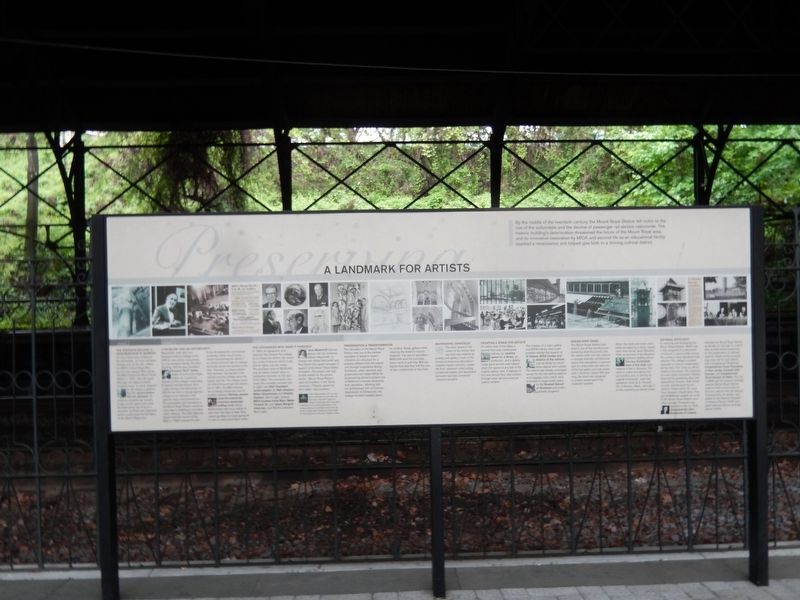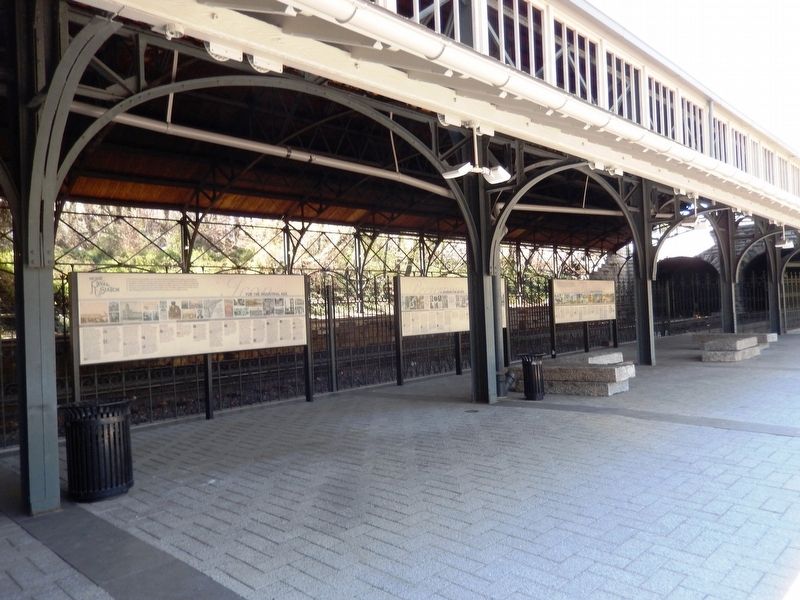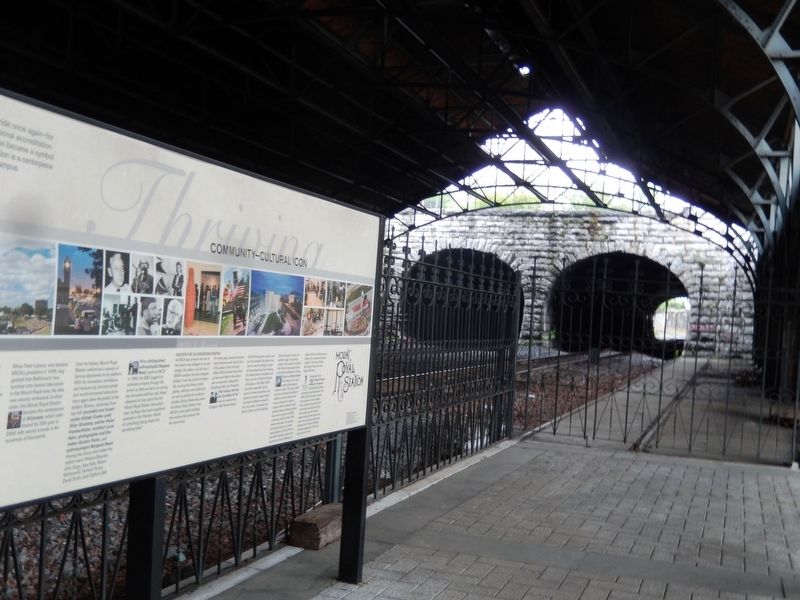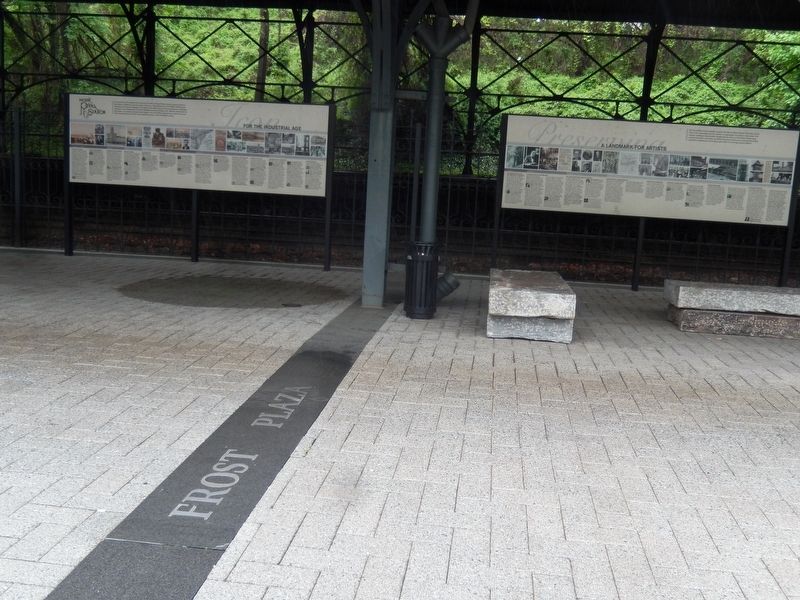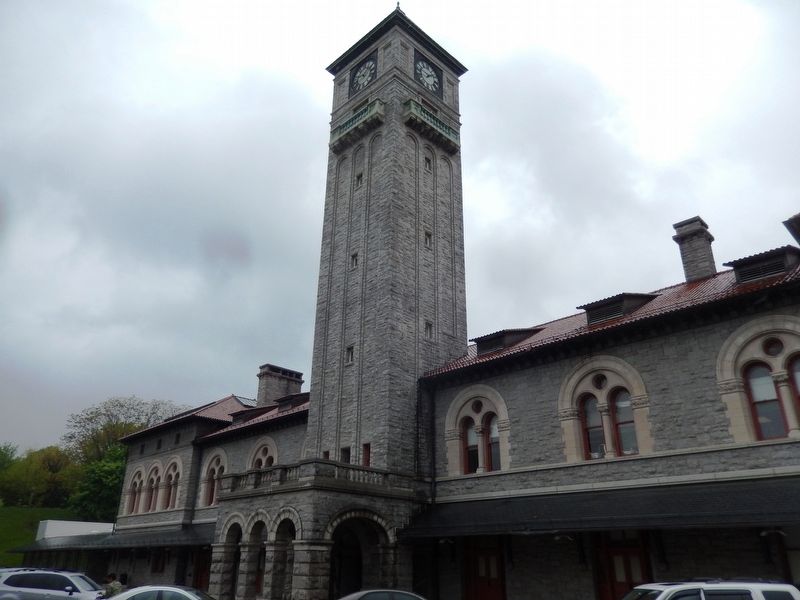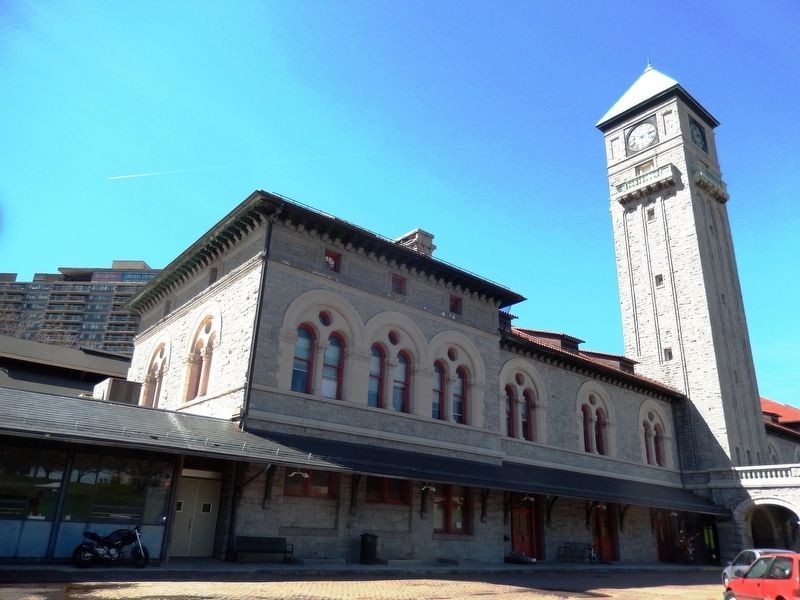Mid-Town Belvedere in Baltimore, Maryland — The American Northeast (Mid-Atlantic)
Mount Royal Station
Preserving-A Landmark For Artists
By the middle of the twentieth century, the Mount Royal Station fell victim to the rise of the automobile and the decline of passenger rail service nationwide. The historic building’s deterioration threatened the future of the Mount Royal area, and its innovative restoration by MICA and second life as an educational facility sparked a renaissance and helped give birth to a thriving cultural district.
[Captions:]
1961-The Station’s Decline-A Neighborhood in Jeopardy
As more Americans embraced the automobile, rail travel declined sharply, and by the late 1950s, the B&O famed Royal Blue service had ceased. Reluctantly, the B&O closed the Mount Royal Station in 1961, after 65 years. Although the adjacent tracks remained busy, no trains stopped on the station’s platform, and the vacant station fell into disrepair, its windows smashed by vandals. Local concern grew over what the impending loss of such a venerable landmark and important anchor would mean for the future of the Mount Royal area.
1965-A Problem-And An Opportunity
Meanwhile, what was now Maryland Institute College of Art (MICA) was quickly outgrowing its only academic facility, the Main Building. MICA’s new president Eugene “Bud” Leake, began to look at the empty station as a potential solution to the college’s expanding programs and enrollment. Bud Leake oversaw the first phase of MICA’s rise from a strong regional college to an institution with national reach and prominence. The acquisition and renovation of the Mount Royal Station would be a key step in building an innovative urban campus. The C&O Railroad (which took full control of the B&O in 1963) wanted the site to be developed for commercial purposes, which would have meant demolishing the station—an all-too-common fate of railroad terminals across the country at the time. However, a unique partnership between key figures in the railroad and the college gave the station new life. The college could not afford to purchase the station, but in 1961, the B&O allowed the building’s temporary use for overflow classes. Painting classes used the previously luxurious passenger waiting room where Baltimoreans had once waited to take their first trips to New York, waved goodbye to troops going off to war-or welcomed them home.
1961-1965 The Visionaries Who Made It Possible
In 1964, an agreement was reached that allowed the college to purchase the station, the nearly four acres of land on which it sits, and air rights over the tracks. The purchase price of $250,000 was far below the market value-a substantial donation on the part of the B&O. The visionaries who made this possible included (left to right, top) B&O President Jervis Langdon, Jr.; B&O directors Milton Eisenhower and Charles Garland; (left to right, bottom) MICA trustees Irving Blum, Walter Pinkard, Sr. and Jesse Slingluff, chairman; and MICA’s president Bud Leake.
Jane Meyerhoff (shown above with her husband, Robert Meyerhoff), co-chaired with Adrian McCardell and Paul Swett the capital campaign in support of the Mount Royal Station renovation. The project was supported entirely by the private sector. “Mount Royal Reborn” read the headline in the News American. (“Station saved for Art’s Sake” said another.)
“Now Baltimoreans will not only know what time it is, but they will also know that their lovely old station is humming with a new kind of activity as our current generation of art students learns its craft there and as the city itself is invited back inside the sturdy walls for the enjoyment of the arts.” Eugene Leake.
1965-1966 Preservation & Transformation
The renovation of the Mount Royal Station was one of the earliest examples of adaptive reuse—utilization of a structure for a purpose different from the original one through imaginative design. Architects, urban planners, and preservationists hailed MICA for its pioneering efforts to protect one of Baltimore’s favorite landmarks from demolition. Working with the architectural firm of Cochran, Stephenson & Donkervoet, the college doubled useable space for studios, library, gallery-while retaining the station’s historic character. The cost of renovation - $650,000 plus the purchase price - came to just over $20 per square foot, less than half the cost of new construction at that time.
Maintaining Grandeur
The open space in the center of the former waiting room was retained as a lobby and gallery; much of the interior architectural decoration—massive marble columns, mosaic tile floor, stamped metal ceiling, ornamental plaster, and decorative ironwork—was also preserved wherever possible.
Creating a Space for Artists
On either side of the lobby, a second floor was constructed halfway up, creating space for a library, and auditorium, and a gallery. Large glass-arched walls helped retain the spacious airy feel of the original waiting room. A stairway to the new second floor was created through what had once been an exterior window.
The creation of a major galley and MICA’s library were made possible through the support of Al Decker, MICA trustee and director of the railroad, and his family, for which these spaces were named. The exterior was virtually unchanged, except for the rear waiting platform and baggage room, which were enclosed to create studio space for the Rinehart School of Sculpture and under-graduate programs.
Saving Rare Gems
The Mount Royal Station train shed is one of the country’s last remaining shed structures. Like the station itself, the train shed is a uniquely dramatic architectural space that exemplifies a now-rare type of construction and was one of the last gable-roof train sheds built in America. Nearly 500 feet long, the shed was designed to protect passengers from inclement weather.
When the clock and tower were badly damaged by a storm, repairs were financed by Jacob Blaustein H’64, and alumnus of the Maryland Institute’s drafting school. The four illuminated dials of the clock each measure 9 feet in diameter. The clock is visible throughout the surrounding area. It still has its original-mechanism, eight-day pendulum clock by E. Howard Co. of Boston, Mass., although it is now wound by an electric motor.
National Spotlight
In restoring and developing the Mount Royal Station, MICA was in the vanguard of a nationwide movement in communities across the country to save abandoned train stations. The college’s creative approach to historic preservation led the New York Times to call the station’s conversion “the keystone of a news urban movement.” Articles featuring this pioneering effort also appeared in Fortune, Wall Street Journal, Architectural Forum, Historic Preservation, St. Louis Post Dispatch, Washington Post, and all Baltimore papers. As word of the Mount Royal Station renovation spread, Congress was inspired to act. In 1972, Congressman John Brademas of Indiana selected the Mount Royal Station as the site for hearings on a bill to help provide federal assistance for the preservation of railroad stations. Others at the proceedings were, left to right, above, with Congressman Brademas, Congressman Frank Thompson of New Jersey, Counsel Jack Duncan and Congressman Orval Hansen of Idaho. The trip to MICA got the positive coverage desired. Mount Royal Station inspired other communities to find news uses for their old stations. Subsequently, the station was added to the National Register of Historic Places (1973) and given national historic landmark status (1976).
Topics and series. This historical marker is listed in these topic lists: Arts, Letters, Music • Railroads & Streetcars. In addition, it is included in the Baltimore and Ohio Railroad (B&O) series list. A significant historical year for this entry is 1961.
Location. 39° 18.359′ N, 76° 37.199′ W. Marker is in Baltimore, Maryland. It is in Mid-Town Belvedere. Marker is on Cathedral Street. This marker is the middle marker of the three markers that were placed side by side. Touch for map. Marker is at or near this postal address: 1400 Cathedral St, Baltimore MD 21201, United States of America. Touch for directions.
Other nearby markers. At least 8 other markers are within walking distance of this marker. A different marker also named Mount Royal Station (here, next to this marker); a different marker also named Mount Royal Station (here, next to this marker); Douglas L. Frost (a few steps from this marker); The Lyric Theatre (about 400 feet away, measured in a direct line); Rene Townsend (Chicago IL, 1952 - 1998) (about 400 feet away); The Maryland Line Monument (about 400 feet away); Anne Morris Owings (about 400 feet away); Lanvale Memorial Garden (about 600 feet away). Touch for a list and map of all markers in Baltimore.
Credits. This page was last revised on November 25, 2022. It was originally submitted on May 16, 2017, by Don Morfe of Baltimore, Maryland. This page has been viewed 280 times since then and 13 times this year. Last updated on October 21, 2022, by Carl Gordon Moore Jr. of North East, Maryland. Photos: 1, 2, 3, 4, 5, 6. submitted on May 16, 2017, by Don Morfe of Baltimore, Maryland. • Devry Becker Jones was the editor who published this page.
